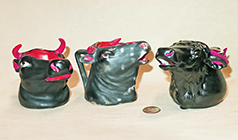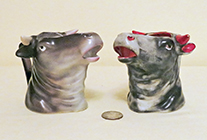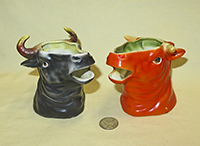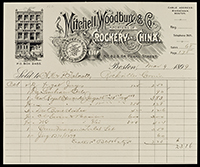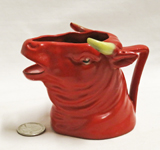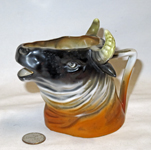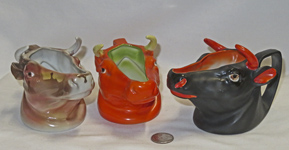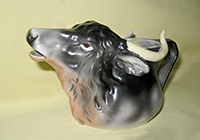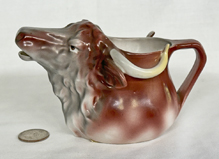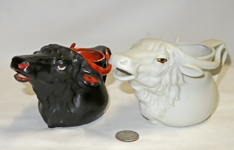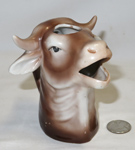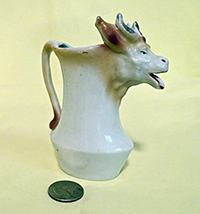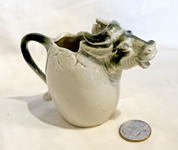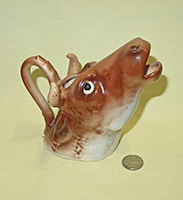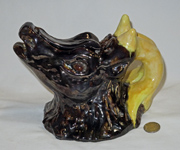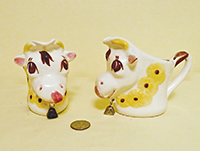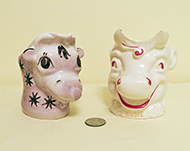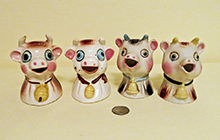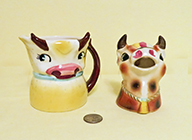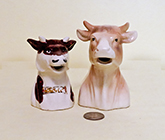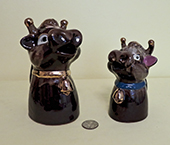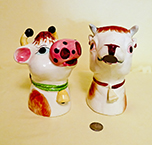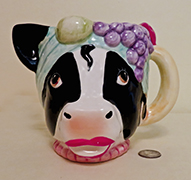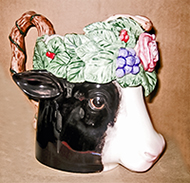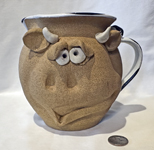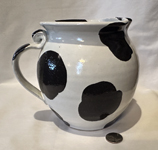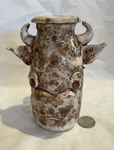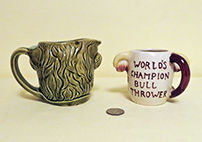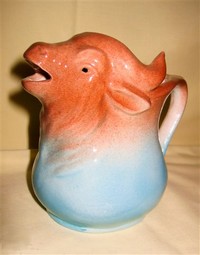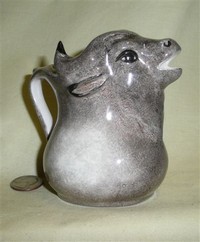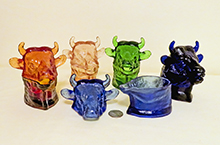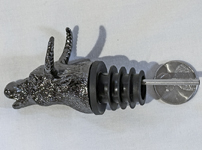Click on any thumbnail for a larger picture.
The nicest of the head creamers are the porcelain ones made by Royal Bayreuth – these come in a
variety of colors and styles. These
three – actually two cows or bulls (hard to tell sometimes when all you have is the head) and a water buffalo – bear the Royal Bayreuth, Bavaria stamp. The other two cow heads are impressed Deponiert (as are some of the ones with the Royal Bayreuth stamp) but without
the crest.
|
Here are three more nice examples of Royal Bayreuth cow or bull head creamers. To reiterate a bit of
what’s in the Favorite Brands section, Royal Bayreuth has been produced in the same factory in Tettau,
Bavaria, since 1794. They have used a number of different marks, usually including the Bavarian coat of
arms, two lions rampant and a shield. The crest, name Royal Bayreuth and Bavaria were used from 1870-1919,
and some later ones may say Germany or even U.S.Zone from 1945-49. Many made for export also bear an
impressed 'Deponiert' which in English translates to deposited. Next, here are some that were either made
by Royal Bayreuth for other companies, or at least bear a close resemblance.
|
These two heads are marked for the Mitchell Woodbury Company of Pearl Street, Boston. I haven't bee able
to find a date for their founding, but is was obviously quite some time before the 1899 date shown here on
their billhead (source www.historicnewengland.org). They were retailers of china and glassware, with many of
their items coming from high end German and Silesian porcelain factories, as well as from Lamberton Works of
New Jersey. Sometime in early 20c they moved to Atlantic Ave in Boston - and apparently they weren't the most
scrupulous of Boston firms since I have found records of a successful 1930's suit brought against them
by Albert Pick-Broth Co. for their actions in not only hiring away employees but encouraging them to being
their customer lists and production information. This suit ultimately made it all the way to the Supreme Court. Mitchell
Woodbury was apparently active until the early 1940s.
|
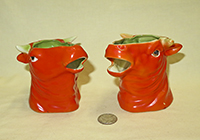 |
As noted above Mitchell Woodbury Co. was an importer and retailer. As shown here, at least some of their
items were apparently manufactured by Royal Baureuth, whose red cow head creamer is shown here next to the one marked
MW Co, which was also in the section just above.
|
Yet two more - another small (3 1/2" tall) red one with yellow horns, and a multicolored one (4 1/2" tall). Neither of these was marked; both were sold as Royal Bayreuth but my suspicions are that since they don't have the RB mark they were made for some other importer - perhaps MW since the cow on the right is from the same mold as the black ones from them.
|
 |
Here are two more heads that bear a resemblance to the Royal Bayreuth creamers. The “Blackpool” crested
one (which is in the same series as the 3 similar to it that are shown in the Ads and Souvenirs Theme) has
the “foreign” in a circle stamp, typical of imports to the UK, and seems to me to be very similar to those from
the Royal Bayreuth molds. The gaudy one on the right is unmarked, but obviously from a different mold.
|
This is a second form of Royal Bayreuth cow or bull head - in this case they are actually 'pitchers' since
there is no hole in the mouth. Still beautifully modeled, and in a variety of colors.
|
The third type of Royal Bayreuth head creamer features a water buffalo, with the long curled horns. These are again 'creamers' with the hole in the mouth.
|
Like the other Royal Bayreuth cow or bull head creamers, their water buffalo seem to be popular for
copies or at least similar versions. These two lovely examples could easily be mistaken for Royal Bayreuth,
but for the 'Made in Taiwan' sticker on the base of the bisque white one. Both are really very well made,
and considerably less expensive than their Bavarian cousins.
|
|
This lovely realistic head is unmarked but is known to be German porcelain, dating from between the World Wars.
|
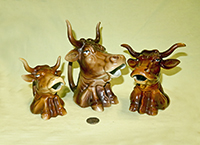 |
These lovely German bull heads date from the early 1900s – I know this because the largest of the three
came with a note that said his mother purchased it in 1909…for fifty cents! She had a large creamer
collection and this was her favorite. They are no longer quite so cheap. I also believe that they were
made in just these three sizes, and it has taken me many years to acquire one of each.
|
|
Here’s another German bull, this time with both head and tail mounted on a vase shaped container. I would
guess it to be early 20c. Although it’s not marked for Germany it does have a mold number near the base,
and that plus the quality and humor are a pretty good indication of its provenance.
|
|
This bull's head - German I believe, hard bisque and imaginatuive - is proudly mounted on a cracked egg shell. It does have a mold number. It came to me from France,
with postage 3x the price of the very intriguing cow creamer. I'd date it to early 20c when these type pieces were so very popular, and I'd hzard a guess it was made near
Rondstadt where factories like Schafer and Vater were producing such clever items.
|
|
This magnificent beast is stamped for Austria under a crown. I have a very similar one marked for "Royal
Floretta Ware, Austria". I have seen others for sale with yet additional marks - leading me to believe that
these are all faux attributions, although for whatever reason I can't guess.
|
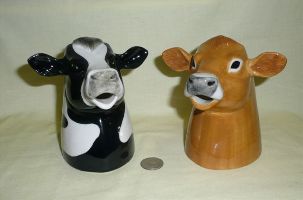 |
Moving off the continent to the UK, this beautiful Fresian and Jersey hail from Quail Ceramics of Church
Lane, Deal, Kent, whose web site notes that they have been in the giftware business for over 20 years, and
have their designs made by small family businesses in Thailand. Quail is best known for their animals,
birds, and especially (ugh!) cats…they have a range of named cats called “The Moggies” that apparently are
quite popular, although why anyone would be the least interested in collecting ceramic cats is completely
beyond me. Cow creamers of course are quite a different story. Of these two, the Fresian came first, and
bears a simple “Q” as the makers mark on its base, while the Jersey’s mark reads “Quail, 2010”. Perhaps
others will follow.
|
 |
Indeed, just as postulated in the section above, another lovely Quail head did follow the Fresian and
Jersey…this is a beautifully crafted and quite large Hereford Bull.
|
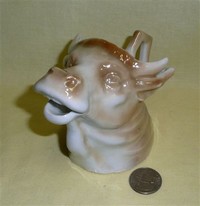 |
This is an interesting light brown luster-glazed head that came from the UK via eBay, but is unmarked.
The seller termed it art deco, which doesn’t seem unreasonable to me.
|
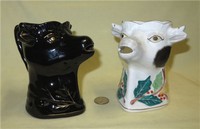 |
Here are two very unusual and quite large English creamers from the early to mid 19c. The molds are
identical, albeit the white one is ceramic and the black one is made from the red clay typical of Jackfield
creamers, and indeed has the Jackfield glaze with gold highlights. These were both quite expensive and the
shipping prices from the UK were high, but they are sufficiently lovely as well as unusual that I couldn’t
resist them. Thankfully the sellers packed well and they made it here unscathed.
|
|
This bull head 'pitcher' with a lid is huge and heavy. The yellow handle ends in pointed horns, otherwise I'd think it's more of a fox than a bull. The knowledgable English seller said it's Staffordahire circa 1860, and I havce come to trust their information. |
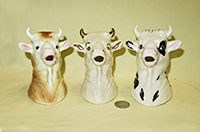 |
Moving over to the US, these three well made creamers are marked for Coventry, Made in the USA, mold #
5563A. I spent some time on the web looking for Coventry, only to find that it’s a quite popular name.
There’s a Coventry in Connecticut, and one in the UK, both with pottery makers…but my guess would be
Coventry Ware of Barberton, OH, that from what I can tell operated from 1932 to about 1950. I could sure
use some help on this one!
|
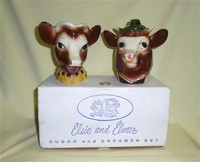 |
Also from the US....here are Borden's Elsie and Elmer, in their original box. There was a long discussion about them in all
their various forms at the start of the Advertising and Souvenirs page but these two being heads, they
naturally must also be shown here
|
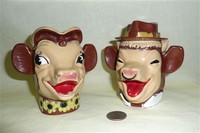 |
This is the plastic sugar and creamer version of Borden’s Elsie and Elmer, featured in Ads and
Souvenirs. As noted there, and as with Royal Bayreuth heads, there have been a lot of copies of this
favorite cow.
|
 |
Here are two different renditions, both from Japan.
|
And, here are some Elsie knock-offs ,or at least "sort-of" Elsies. The ones in the left
picture and the purplish one in the right shot are marked for Gayet of California. I
can find other things by them - notably a bunch of ceramic eggs - on the web, but no
information about the company. The white one on the right proudly says "Elsie" on her
collar, but has no markings. I believe it's likely from Japan.
|

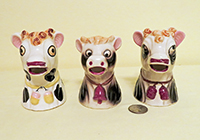
These vintage Japanese cow head creamers with curls o0n their foreheads come up -
at least some of them do - fairly often on ebay. There are small variations in the
color and number of bells among those in the left hand picture, and in the right hand
one the center cow with crossed eyes is flanked by a couple that appear to have acorn
shaped bells.
|
| |
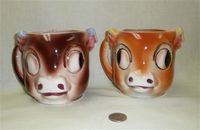 |
More Japanese versions – but pitchers rather than creamers that pour from the mouth.
|
On the left are yet two more Japanese cow head creamers, and on the right a head from the same mold as the
light brown one on the left.
|
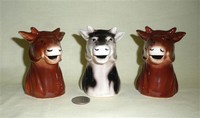 |
Happy, happy, happy … looking extremely pleased with themselves are three more versions of the small
creamer on the far left above. Like it, they are simply stamped “Japan” (black and white cow) or “Made in
Japan” (brown cows)
|
|
Although unmarked, these two are also from Japan. After all, no one else puts balls on the top of horns. There's a similar one to the larger of these on the sugar and creamers page.
|
|
These two both have ‘voice boxes’ fitted into the bottom, so that they should ‘moo’ when tipped up. I
say ‘should’ moo, but they seem to have a bad case of laryngitis, presumably from a combination of age and
repeated use. I have yet to find one where the ‘moo-er’ actually works, and most of them available on ebay have lost the voice box.
|
 |
The two brown creamers shown here both came from the UK (via eBay). The seller of the one on the left
said that he had dug it out of a ‘1920-1930’s tip’. The blue one in the middle came from Australia
|
|
This large, crackled steer head pitcher with an angled handle is unmarked, but a kind reader who has a similar one ideltified it by googling the image of hers. At one time they were sold by a company called West Elm that has a store on Logan Circle in DC...and there was this one and a larger one. The West Elm web site states that they were made by a pottery called Art in the Forest that is located in Cape Town, South Africa. Googling them I find " Art in the Forest is a striking Bauhaus building nestled in Cecilia Forest, off the Constantia Nek Circle. We showcase a beautiful ceramic gallery exhibiting a wide range of ceramic art as well as an interactive ceramic studio. Our in house line aptly named 'FORESTWARE' is produced on-site and is sold to local and international clients. Art in the Forest runs outreach programs in support of the Light from Africa Foundation, which offer disadvantaged kids access to creativity by offering free clay education and workshops. From the terrace one overlooks a large, indigenous garden and the entire Peninsula below. Enjoy a cup of coffee, whilst you peruse our gallery and find out about our diverse and exciting projects." Neat. Of course I tried to contact them, but without luck. My lovely steer pitcher came with a broken left horn (well wrapped but the package shifted around in the box) so the seller kindly refunded the purchase and shipping price...but I couldn't resist sticking the horn back on and it displays quite well albeit I'm reluctant to put it to use.
|
Here are two large cow head pitchers, both shown elsewhere. “Cowmen Mooranda” by Vandor, 1988, was shown as an example of a cow pitcher on the "My Story" page, and Fitz and
Floyd’s lovely Heidi Holstein, of 1994, 1 ½ quart size, was also featured in Favorite Brands.
|
| |
Here's a third big one, a black bull’s head version of a 'face jug' entitled “no.1 cow”,
by Linda Corn of Lula, Banks County, Georgia, dated 12/99. Face jugs are a grand old southern US folk art tradition.
Linda is the wife of Roger Corn who seems to be even better known for his face jugs, and has his own web site. |
This face jug is actually designed s a pitcher. It has a bit of age to it - and the unknown maker also had a sense of humor,
giving the back side holstein colors. My wife claim,s it';s too ugly to have upstairs for use, so it joined its colleagues in the cow room.
|
| |
Here's a third face jug, or maybe a face vase -handmade American south for sure but unknown maker,
came from Georgia |
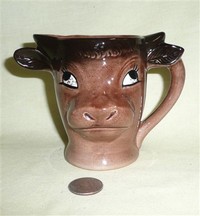
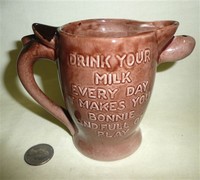
While in the moods for pitchers, here's one I probably would have passed by but for the delightful little
verse on the back: “Drink your milk every day it makes you bonnie and full of play”. English of
course, albeit unmarked.
|
| |
It's interesting that this Goebel version of the cow head pitcher beard such a close resemblance to the one above with the jingle.
It bears a large V bee symbol that unless I'm mistaken dates it to the 1950s. |
More pitchers - a couple mean bulls, neither with maker's information. It is however pretty evident what the one on the right is intended for - albeit exactly what kind of bull is thrown isn't clear.
|
These are buffalo - bull buffalo not cow buffalo and thus doubly inappropriate for the collection but they are attractive, come in a variety of colors, and frequently show up on ebay listed as cow creamers. I can claim just an error of interpretation for the first one I acquired but that excuse won't work for the other one. At least they're inexpensive and not offensive.
|
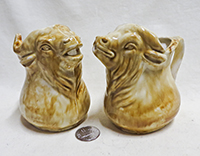 |
On the left is another version of the bull buffalo head, and on the right a somewhat different interpretation, perhaps meant to be a cow buffalo. These are both
marked “Made in Occupied Japan”, so the buffalo head mold has been around for quite some
time.
|
Here's a bunch of glass cow heads that come apart – these are often sold as cow creamers, but I suspect that they were originally
designed to hold mustard or some other condiment.
|
|
Well, it is a bull's head - and it does have two holes. one in one out. And it';s sorta fun, not to mention useful.
And it was inexpensive so what the heck...Straight from China of course
|

